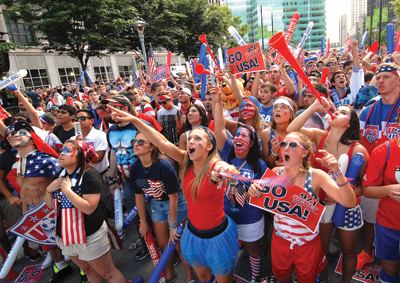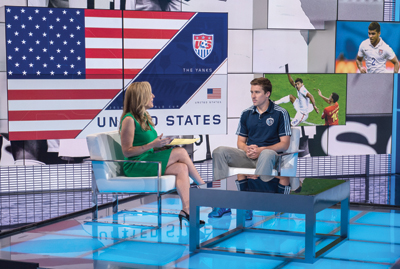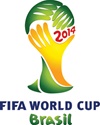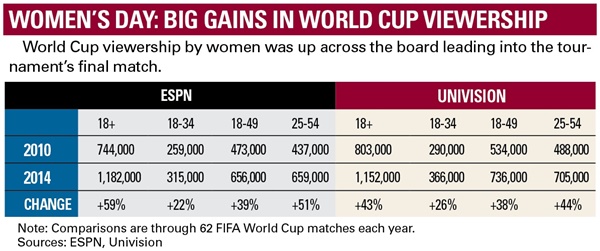The 2014 FIFA World Cup will be remembered as the point where international soccer crossed over into mainstream American culture.
There was U.S. player Clint Dempsey kidding around with David Letterman on “The Late Show.”
DeAndre Yedlin — hardly a household name even in soccer homes — talked it up with “Good Morning America” and “Today.”
Star goalkeeper Tim Howard was the subject of a viral Internet meme after his record-setting 16 saves against Belgium.
And Matt Besler, a central defender with the boyish looks of a first-year accountant, rolled through the “car wash” of appearances at ESPN, quipping with everyone from the radio hosts to “SportsCenter” anchors.
While playing four games in Brazil and advancing to the Round of 16, the U.S. squad regularly merited not just back-page but front-page headlines — 1,523 mentions on the front pages of American newspapers on the four game days and days afterward, to be exact, according to data compiled by U.S. Soccer.
 |
|
From watch parties to television viewership, U.S. women embraced the World Cup games in record numbers.
Photo by: GETTY IMAGES
|
The mainstream embrace of the World Cup over the last four weeks was evident not only in coverage of the U.S. national team but also in the thousands of Americans who traveled to Brazil, the eye-opening public turnouts for viewing parties and viewership on both ESPN and Univision, which posted record ratings and viewership for the event.
For U.S. media executives, the sport’s TV ratings this month provide the clearest signal of across-the-board acceptance for a tournament that was not popular enough in the U.S. to even collect a media rights fee through the early 2000s.
The record viewership numbers dominated the talk around the event, as ESPN and Univision saw huge ratings jumps across all demographics for World Cup games.
But network executives cited gains with the female and older male demos as the surest sign yet that the World Cup’s popularity reached new heights.
In fact, more young women than young men watched the Brazil-Mexico game June 17 on the Spanish-language channel Univision. A whopping 1.793 million women ages 18 to 49 watched the match on Univision, compared with 1.714 million men.
“We’ve never seen anything like that,” said Debbie Shinnick, Univision’s senior vice president of network sales and strategy research. “The fact that we kept these women around to watch soccer is incredible.”
ESPN, a TV bastion for American men, saw strong increases in every female demographic throughout the monthlong tournament. ESPN said a record 42 million women watched games in the group stage, a higher number than tuned into female-skewing networks like Lifetime, HGTV and Bravo during that same two-week period.
This wasn’t just patriotism. Research shows big viewership gains even when the U.S. team wasn’t playing. If you strip away the U.S. games, ESPN saw a 43 percent viewership increase over South Africa. With the U.S. games included, ESPN’s viewership is up 41 percent from four years ago.
“The broad interest in the sport is a little surprising,” said Artie Bulgrin, ESPN’s senior vice president of research and analytics. “These are all significant numbers that speak to the growth of international soccer in the United States.”
The World Cup also showed surprising growth among older viewers, which shouldn’t be altogether surprising considering it was played in time zones more attractive to the United States. As of last Wednesday, TV ratings in the men 65-and-older demo on ESPN were up 103 percent and ratings in the men 50-to-64 demo were up 50 percent from the 2010 World Cup in South Africa.
Growth in these demos generally means nothing for TV networks — advertisers aren’t clamoring to get in front of older men. But this type of growth among the oldest male demos is as good an indicator of mainstream acceptance as any other statistic since older men generally have been slower to adopt soccer.
While all of this is encouraging for FIFA and its World Cup, the big question being asked in sports circles is whether the event’s broad popularity will translate to more general acceptance for soccer.
U.S. Soccer already is trying to capitalize on the momentum it gained in Brazil. It is planning to bid for the next available World Cup in 2026 in hopes of returning it to the U.S. for the first time since 1994.
“My expectation is that we will bid for the 2026 World Cup at some point,” said Sunil Gulati, the president of the U.S. Soccer Federation and a member of the FIFA executive committee. “We want to bring the FIFA World Cup back to the United States.”
ESPN and NBC Sports Group already have developed marketing campaigns for Major League Soccer and the English Premier League using World Cup stars such as Besler and Howard, respectively.
Early MLS television results have been strong since the U.S. national team finished playing. A Kansas City-Chicago game on July 6 drew 495,000 viewers to ESPN, more than double last season’s average audience on the network (220,000).
U.S. soccer certainly has been down this road before. The 2010 World Cup in South Africa set ratings records, but ensuing MLS games on ESPN did not see a significant jump. Network executives say people should manage their expectations as it relates to the sport’s growth in the United States.
 |
|
Matt Besler (with Linda Cohn) visited ESPN as the team drew unprecedented media coverage.
Photo by: RICH ARDEN / ESPN
|
“I would caution that we have seen this before,” Univision’s Shinnick said. “It’s going to be a testament whether we actually see an overall growth beyond the World Cup in soccer numbers.”
Marketers will be looking for the same thing.
“Is football as a business platform more sustainable moving forward? That’s what we’re all going to be asking,” said Derek Aframe, Octagon, executive vice president. “I think you’re going to continue to see positive momentum moving forward.”
FIFA sponsors and partners anticipated there would be a surge in World Cup interest among Americans and devoted more marketing dollars to promotions in the United States than previous World Cup events. Coca-Cola’s program in the U.S. was comparable to what it does for a Summer Olympics, and McDonald’s for the first time sent 25 American children to participate in its player-escort program before World Cup matches.
Those bets and others were rewarded by the record ratings, viewing parties and coverage of the tournament in the U.S.
Sponsor executives said the results not only affirmed their bet on soccer but also confirm their companies’ plans to continue to support the sport in the coming years by activating around the 2015 Women’s World Cup in Canada. They also anticipate it changing how they make decisions about what percentage of global marketing dollars should be spent in the U.S. during the 2018 World Cup in Russia.
“All signs were tracking toward [a strong World Cup] based on attendance growth with MLS, but we were overwhelmed by the support,” said Ernesto Bruce, Adidas’ director of soccer. “With Europe, with South America, [in the past] we had to defend ourselves and explain that soccer is relevant in the U.S. We have great ammunition now. Really, no one outside the U.S. can say soccer is not relevant in this country. The facts don’t lie.”
Others are confident that what took place this summer around the World Cup is bigger than what happened around the event four years ago in South Africa.
“This time it felt different to me. It feels like we crossed a threshold,” said Scott Blackmun, CEO of the U.S. Olympic Committee, who played soccer at Dartmouth. “All of my friends that I played with and all of the people I know who watch soccer watched [this World Cup], but I don’t remember seeing people packed in bars to watch games before and we saw that. There has been a sea change in how soccer has been perceived.”
Scott Guglielmino, ESPN’s senior vice president of programming, says that in just four years, the networks have become savvier about how to use the World Cup’s popularity to market the sport in the U.S.
“We’re more buttoned up,” he said. “We are better at doing it in an organic way. Several of the players who are featured on the World Cup team are MLS guys. One of the things we’re doing is making sure that all of our editorial folks realize that there’s that connection.”







